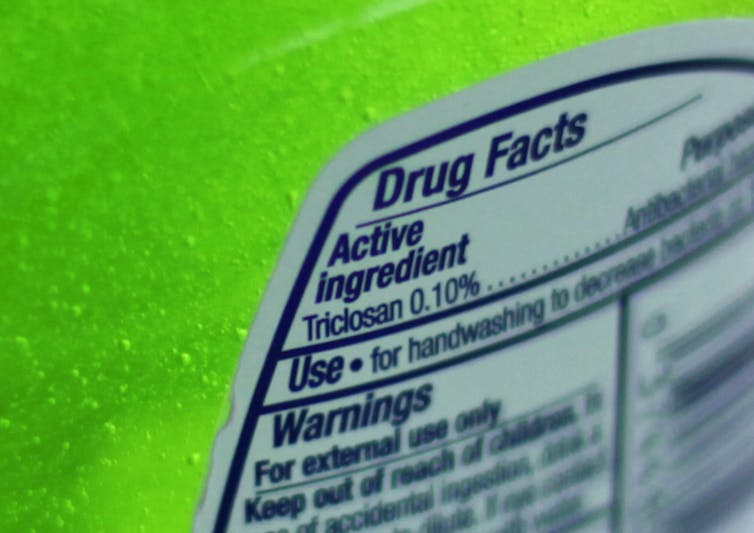Many household products contain antimicrobial chemicals banned from soaps by the FDA – CWEB.com

Any antimicrobial chemicals in there?
Home image via www.shutterstock.com.
Erica Hartmann, Northwestern University
This year marks 20 years since Hasbro was fined for false advertising, claiming their Playskool toys laden with the antimicrobial chemical triclosan would keep kids healthier. It is also the year when soap manufacturers will finally have to remove the chemical from their products.
Triclosan is one example of a potentially hazardous chemical used in some antimicrobial products. The Food and Drug Administration recently banned it, along with 18 others chemicals, from hand soaps because of unacceptable risks to humans and the environment. Exposure to triclosan in general is linked with disruption of hormone function and the development of antibiotic resistance in bacteria.
The FDA asked manufacturers to demonstrate that these chemicals are safe for long-term use and more effective than regular soap. Neither has been proven.
But these same chemicals are still used in many other products — including plush toys, pool wings, pacifier pockets, building blocks and even craft supplies like markers and scissors — without any label required. Some of these products are marketed as being antimicrobial, but many aren’t.
Because these products are not under the purview of the FDA, they aren’t subject to the ban, and companies aren’t required to reveal what makes them antimicrobial. This means it is hard for consumers to know what products contain these chemicals.

Why was triclosan banned in soaps?
Manufacturers failed to demonstrate that antimicrobial soaps were any more effective than regular soaps. Essentially, there are no reported benefits of antimicrobial soaps to outweigh the risks of using antimicrobial chemicals. So, are these chemicals any more effective in other products?
Overall, peer-reviewed research showing that household products and building materials containing antimicrobial chemicals, such as cutting boards and industrial flooring, harbor fewer bacteria is scant. Research further demonstrating that these products protect human health is essentially nonexistent. This indicates that, much like in soaps, triclosan in other products isn’t doing much good.
The FDA’s decision applies only to over-the-counter soaps sold to consumers, and not to soaps used in health care settings or any other consumer products or building materials not under the purview of the FDA.
[youtube https://www.youtube.com/watch?v=9TXBP1t2rUc&w=560&h=315]
But some health care providers are deciding to skip the antimicrobials. For example, Kaiser Permanente, a major health care system, stopped purchasing soaps containing triclosan several years ago. And in 2015 the system announced it would no longer use paint and interior building products containing antimicrobial chemicals, citing a lack of evidence that they actually prevent disease along with safety concerns.
Not only does research suggest that antimicrobial products are ineffective at reducing microbes on the product, but several studies also suggest they may be causing an increase in antibiotic resistance. Antibiotic-resistant infections, such as MRSA, cause an estimated 23,000 deaths every year in the United States.
Research that I conducted at the Biology and the Built Environment (BioBE) Center at the University of Oregon demonstrated a troubling link, finding higher concentrations of triclosan and antibiotic resistance genes in dust in an athletic and educational facility. We are currently investigating how these antibiotic resistance genes can get into bacteria.
At the moment, it’s unclear how much of the triclosan we find in dust comes from soaps or other products, but triclosan has been found in almost every dust sample assayed worldwide. This suggests that the more antimicrobial chemicals we use in our homes, classrooms and offices, the more antibiotic-resistant bacteria we see there.
Again, it is worth noting that we have no evidence that using any antimicrobial products other than toothpaste, whether they are soaps or other household goods, makes us any healthier. There is even some evidence to the contrary: Without adequate exposure to the right microbes, our children may be at a higher risk of developing conditions like allergies and asthma.
Why it’s hard to know what products contain these chemicals
Let’s say, then, that we want to avoid products that contain triclosan or any of the other 18 antimicrobials banned in soap by the FDA. Should be fairly easy, right? Not so: Manufacturers are not required to tell us what makes their products antimicrobial.
Soaps are personal care products, which means they fall under the FDA’s jurisdiction. The agency requires that active ingredients such as triclosan be listed. For instance, triclosan is also found in some toothpastes, in which it has been proven effective against plaque, and it is listed on the label.
If you want to avoid buying soaps containing these chemicals before the ban goes into effect on Sept. 6 you just need to read the label. But products that are not under the agency’s jurisdiction are subject to different requirements, and don’t have to list the chemicals they contain. It is incredibly difficult — if not impossible — to find out exactly which products contain which antimicrobial chemicals.
Products that are marketed as being antimicrobial, for instance, often contain these chemicals. But not all products that contain antimicrobial chemicals are advertised as such.
Concerned consumers can get recommendations from advocacy groups like the Environmental Working Group and Beyond Pesticides. However, that information is focused largely on triclosan and not the additional 18 chemicals banned from soap. And as manufacturers reformulate products without making public announcements, information may be incomplete or out of date.
Consumers looking for a simple way to get comprehensive information about antimicrobial products are out of luck. But one consumer with an awful lot of resources is actually starting to collect this information: Google. The tech giant went to such great lengths to uncover the ingredients for products used in their facilities that it developed an online tool called Portico. Unfortunately for us, Portico isn’t yet available to the public.
It would help if regulators adopted consistent standards requiring common labeling practices, and if manufacturers were required to disclose hazardous ingredients. We need to know what chemicals are in the products, especially when those chemicals could have adverse effects on our health and our environment.
![]() What can consumers do? We can apply pressure by calling on retailers to carry antimicrobial-free products and to require clear labels on products that contain chemicals banned by the FDA.
What can consumers do? We can apply pressure by calling on retailers to carry antimicrobial-free products and to require clear labels on products that contain chemicals banned by the FDA.
[youtube https://www.youtube.com/watch?v=9TXBP1t2rUc&w=560&h=315]
Erica Hartmann, Assistant Professor, Northwestern University
This article was originally published on The Conversation.


